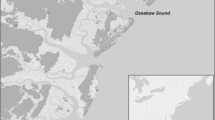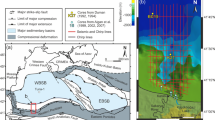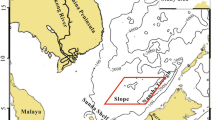Abstract
Interpretation of sidescan-sonar imagery provides evidence that down-slope gravity-driven movement of the nepheloid layer constitutes an important mode of transporting sediment into the basins of north-central Long Island Sound, a major US East Coast estuary. In the Western Basin, this transport mechanism has formed dendritic drainage systems characterized by branching patterns of low backscatter on the seafloor that exceed 7.4 km in length and progressively widen down-slope, reaching widths of over 0.6 km at their southern distal ends. Although much smaller, dendritic patterns of similar morphology are also present in the northwestern part of the Central Basin. Because many contaminants display affinities for adsorption onto fine-grained sediments, and because the Sound is affected by seasonal hypoxia, mechanisms and dispersal pathways by which inorganic and organic sediments are remobilized and transported impact the eventual fate of the contaminants and environmental health of the estuary.






Similar content being viewed by others
References
Beaulieu E, Poppe LJ, Paskevich VF, Doran EF, Chauveau BE, Crocker JM, Beaver AL, Schattgen PT (2005) Sidescan sonar imagery and surficial geologic interpretation of the seafloor off Bridgeport, Connecticut. US Geological Survey Open-File Rep 2005-1162, DVD
Bokuniewicz HJ, Gordon RB (1980) Storm and tidal energy in Long Island Sound. Adv Geophys 22:69–106
Buchholtz ten Brink MR, Mecray EL, Galvin EL (2000) Clostridium perfringens in Long Island Sound sediments: an urban sedimentary record. J Coast Res 16:591–612
Coleman JM, Prior DB (1988) Mass wasting on continental margins. Annu Rev Earth Planet Sci 16:101–119
DiGiacomo-Cohen ML, Tedesco M, Polloni C (1998) Digital bathymetric contours from NOAA charts as organized for the LISSGIS library. In: Poppe LJ, Polloni C (eds) Long Island Sound environmental studies. US Geological Survey Open-File Rep 98–502, CD-ROM
Eldridge R (2006) Tide and Pilot Book. White, Boston, MA
Flint RF, Gebert JA (1976) Latest Laurentide ice sheet; new evidence from southern New England. Geol Soc Am Bull 87:182–188
Hampton MA (1972) The role of subaqueous debris flow in generating turbidity currents. J Sed Petrol 42:775–793
Henekel DJ (1970) The role of waves in causing submarine landslides. Geotechnique 20:75–80
Knebel HJ, Poppe LJ (2000) Sea-floor environments within Long Island Sound: a regional overview. J Coast Res 16:533–550
Lewis RS, DiGiacomo-Cohen ML (2000) A review of the geologic framework of the Long Island Sound basin with some observations relating to postglacial sedimentation. J Coast Res 16:522–532
Lewis RS, Stone JR (1991) Late Quaternary stratigraphy and depositional history of the Long Island Sound Basin: Connecticut and New York. J Coast Res Spec Issue 11:1–23
Long Island Sound Study (1994) The Long Island Sound Study—The Comprehensive Conservation and Management Plan. Stamford, CT, US Environmental Protection Agency Rep
Lowe DR (1982) Sediment gravity flows: II. Depositional models with special reference to the deposits of high-density turbidity currents. J Sed Petrol 52:279–297
McCave IN (1984) Mechanics of deposition of fine-grained sediments from nepheloid layers. Geo-Mar Lett 4:243–245
McMullen KY, Poppe LJ, Paskevich VF, Doran EF, Moser MS, Christman EB, Beaver AL (2005) Surficial geology of the seafloor in west-central Long Island Sound as shown by sidescan sonar imagery. US Geological Survey Open-File Rep 2005-1018, DVD
Mecray EL, Buchholtz ten Brink MR (2000) Contaminant distribution and accumulation in the surface sediments of Long Island Sound. J Coast Res 16:575–590
Needell SW, Lewis RS, Colman SM (1987) Maps showing the Quaternary geology of east-central Long Island Sound, scale 1:125,000. US Geological Survey Miscellaneous Field Studies Map MF 1939-B
Pellegrino PE, Hubbard WA (1983) Baseline shellfish data for the assessment of potential environmental impacts associated with energy activities in Connecticut's coastal zone. Hartford, CT, State of Connecticut Department of Agriculture, Aquaculture Division 1
Poppe LJ, Knebel HJ, Mlodzinska ZJ, Hastings ME, Seekins BA (2000) The distribution of surficial sediments in Long Island Sound and adjacent waters: texture and total organic carbon. J Coast Res 16:567–574
Poppe LJ, Paskevich VF, Lewis RS, DiGiacomo-Cohen ML (2002a) Geologic framework data from Long Island Sound, 1981–1990: a digital data release. US Geological Survey Open-File Rep 02-002, DVD-ROM
Poppe LJ, Knebel HJ, Lewis RS, DiGiacomo-Cohen ML (2002b) Processes controlling the remobilization of surficial sediments and formation of sedimentary furrows in north-central Long Island Sound. J Coast Res 18:741–750
Poppe LJ, Paskevich VF, Moser MS, DiGiacomo-Cohen ML, Christman EB (2004) Sidescan sonar imagery and surficial geologic interpretation of the seafloor off Branford, Connecticut. US Geological Survey Open-File Rep 2004-1003, CD-ROM
Poppe LJ, Williams SJ, Paskevich VF (2005) USGS East-Coast sediment analysis: procedures, database, and GIS data. US Geological Survey Open-File Rep 2005-1001, DVD
Poppe LJ, Ackerman SD, Doran EF, Beaver AJ, Crocker JM, Schattgen PT (2006) Interpolation of reconnaissance multibeam bathymetry from north-central Long Island Sound. US Geological Survey Open-File Rep 2005-1145, DVD
Poppe LJ, Williams SJ, Moser MS, Stewart HF, Forfinski NA, Doran EF (2008) Quaternary geology and sedimentary processes in the vicinity of Six Mile Reef, eastern Long Island Sound. J Coast Res 24:255–266
Prior DB, Coleman JM (1978) Disintegrating retrogressive land-slides on very low-angle slopes, Mississippi Delta. Mar Geotech 3:37–60
Rhoads DC (1973) The influence of deposit-feeding benthos on water turbidity and nutrient cycling. Am J Sci 273:1–22
Rhoads DC, Tenore K, Browne M (1975) The role of resuspended bottom mud in nutrient cycles of shallow embayments. Estuar Res 1:563–579
Rhoads DC, Boyer LF, Welsh BL, Hampson GR (1984) Seasonal dynamics of detritus in the benthic turbidity zone; implications for bottom-rack molluscan mariculture. Bull Mar Sci 35:536–549
Signell RP, List JH, Farris AS (2000) Bottom currents and sediment transport in Long Island Sound: a modeling study. J Coast Res 16:551–566
Stone BD, Borns HW (1986) Pleistocene glacial and interglacial stratigraphy of New England, Long Island and adjacent Georges Bank and Gulf of Maine. In: Sibrava V, Bowen DQ, Richmond GM (eds) Quaternary glaciations in the northern hemisphere. Pergamon, Oxford, pp 39–52
Stone JR, Schafer JP, London EH, DiGiacomo-Cohen M, Lewis RS, Thompson WB (2005) Quaternary geologic map of Connecticut and Long Island Sound Basin, 2 sheets, scale 1:125,000. US Geological Survey, Scientific Investigations Map 2784
Wells JT, Prior DB, Coleman JM (1980) Flowslides in muds on extremely low angle tidal flats, northwestern South America. Geology 8:272–275
Welsh BL (1993) Physical oceanography of Long Island Sound: an ecological perspective. In: Van Patten MS (ed) 1992 Long Island Sound Research Conf Proc, CT-SG-93-03, pp 23–33
Wright LD, Friedrichs CT, Kim SC, Scully ME (2001) Effects of ambient currents and waves on gravity-driven sediment transport on continental shelves. Mar Geol 175:25–45
Yingst JY, Rhoads DC (1978) Seafloor stability in central Long Island Sound Part II Biological interactions and their importance for seafloor erodability. Int Estuar Res Conf 4:245–259 Academic Press, New York
Acknowledgments
We would like to thank the officers and crews of the NOAA ship Rude and the US Merchant Marine Academy's RV Storm, without whose concentrated team effort completion of this project would not have been possible, and Don Rhoads for his helpful discussions. This work, which is part of a long-standing cooperative program to map the geology and better understand the sedimentary processes that have shaped and maintained Long Island Sound, was supported by the Coastal and Marine Geology Program of the US Geological Survey, the Connecticut Department of Environmental Protection, and the Atlantic Hydrographic Branch of the National Oceanic and Atmospheric Administration. This manuscript has benefited from critical reviews by Walter Barnhardt, Ben Gutierrez, and Jim Robb (all USGS).
Author information
Authors and Affiliations
Corresponding author
Rights and permissions
About this article
Cite this article
Poppe, L.J., McMullen, K.Y., Williams, S.J. et al. Estuarine sediment transport by gravity-driven movement of the nepheloid layer, Long Island Sound. Geo-Mar Lett 28, 245–254 (2008). https://doi.org/10.1007/s00367-008-0118-2
Received:
Accepted:
Published:
Issue Date:
DOI: https://doi.org/10.1007/s00367-008-0118-2




